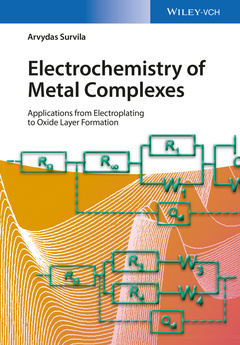Electrochemistry of Metal Complexes Applications from Electroplating to Oxide Layer Formation
Auteur : Survila Arvydas

Starting with general considerations on equilibria in solutions and at interfaces as well as on mass transport, the text acquaints readers with the theory and common experimental practice for studying electrochemical reactions of metals complexes. The core part of the book deals with all important aspects of electroplating, including a systematic discussion of co-deposition of metals and formation of alloys. It also discusses such related subjects as oxide layer formation and hydrogen evolution as a side reaction.
Preface IX
Symbols and Abbreviations XIII
1 Introduction 1
1.1 Equilibrium Properties of Complex Systems 2
1.1.1 General Definitions 2
1.1.2 Equilibrium in the Solutions of Complex Compounds 3
1.1.3 Distribution of Complexes and Ligands in the Solution 6
References 12
2 Equilibrium Electrode Potentials 13
2.1 Electrodes of the First Kind 14
2.2 Equilibria Involving Ions of the Intermediate Oxidation State 18
2.3 Electrodes of the Second Kind 22
2.4 Open-Circuit Potentials: Examples of Experimental Investigations 25
2.4.1 System Cu/Cu(I),CN− 25
2.4.2 System Cu/Cu(II), β-Alanine 29
References 31
3 Mass Transport 33
3.1 Two Models of Linear Mass Transport 35
3.2 Other Cases of Diffusional Mass Transport 39
3.3 Mass Transport of Chemically Interacting Particles 41
3.4 Concentration Profiles 44
3.4.1 Concentration Profiles in Ideally Labile Systems 45
3.4.2 Concentration Profiles in Systems of Limited Lability 52
References 58
4 Peculiarities of Electrochemical Processes Involving Labile Complexes 61
4.1 Steady-State Voltammograms 62
4.2 Potential Transients 68
4.3 Current Transients 69
References 74
5 QuantitativeModeling of Quasi-Reversible Electrochemical Processes Involving Labile Complexes of Metals 75
5.1 Kinetic Equations 76
5.2 Employment of Voltammetric Data 80
5.2.1 Tafel Plots Normalized with Respect to the Surface Concentration of EAC 80
5.2.2 Analysis of LPS Current Maxima 83
5.3 Techniques Based on the Control of the Intensity of Forced Convection 85
5.3.1 Isosurface Concentration Voltammetry 85
5.3.2 Determination of the Exchange Current Density from Polarization Resistance 86
5.3.3 Electrochemical Impedance Spectroscopy (EIS) under Forced Convection Conditions 89
References 93
6 Determination ofMechanism of Electrochemical Processes Involving Metal Complexes 97
6.1 Determination of the Mechanism by Reaction Orders 98
6.2 Method of Isopotential Solutions 100
References 102
7 Adsorption 105
7.1 Thermodynamic Aspects 106
7.2 Model Aspects 108
References 112
8 Electrochemical Processes in Real Systems 115
8.1 Experimental Details 115
8.2 Cyanide Systems 116
8.2.1 System Cu|Cu(I), CN− 117
8.2.2 System Ag|Ag(I), CN− 119
8.2.3 System Au|Au(I), CN− 125
8.3 Ecological Systems Containing Hydroxy Acids 131
8.3.1 Electroreduction of Cu(II) Complexes 132
8.3.2 Electroreduction of Sn(II) Complexes 151
8.3.3 Electroreduction of Zn(II) Complexes 170
Appendix 174
References 174
9 Electrochemical Deposition of Alloys 183
9.1 Mass Transport during the Codeposition of Metals 184
9.2 Codeposition of Cobalt and Tin 185
9.3 Deposition of Brass Coatings 194
9.4 Deposition of Bronze Coatings 205
9.4.1 Surface Activity of Polyethers on Copper and Tin Substrates 206
9.4.2 Effect of Halides. Formation of Surface Complexes 211
9.4.3 Effect of Length of the Hydrocarbon Chain 214
9.4.4 Codeposition of Copper and Tin 217
9.4.5 Related Phenomena: Current Oscillations 223
9.5 Codeposition of Cobalt and Molybdenum 227
References 234
10 Spontaneous Formation of Photosensitive Cuprous Oxide Layers 241
10.1 Two Mechanisms of Cu2O Formation 242
10.2 Composition of Oxide Layers 243
10.3 Kinetics of Cu2O Formation 244
10.4 Electrochemical Reduction of Oxide Layers 246
10.5 Photoelectrochemical Properties of Oxide Layers 251
10.6 Photoelectrochemical Stability of Oxide Layers 255
10.7 Influence of Oxide Layers on Kinetics of Cu(II) Reduction 258
References 263
11 Hydrogen Evaluation Involving Ligands as Proton Donors 267
References 276
Concluding Remarks 277
Index 283
Date de parution : 06-2015
Ouvrage de 304 p.
17.5x25.2 cm
Disponible chez l'éditeur (délai d'approvisionnement : 14 jours).
Prix indicatif 150,36 €
Ajouter au panier


